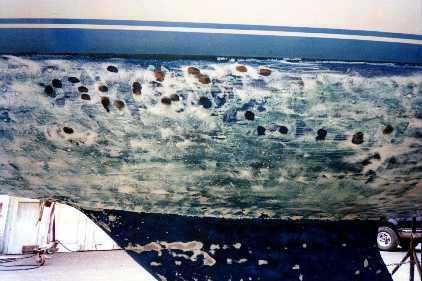Our original survey revealed hundreds of small blisters. The surveyor used his little hammer, tap tapping his way all around the hull, and assured me that there was no serious or deep problem. He showed me another boat in the same yard where the problems were deeper and a portion of the hull had to be taken down to get rid of all the brown material in the fiberglass layup. He had identified the problem with his same little hammer. He recommended I remove the bottom paint from my hull immediately after haul out and run a sander lightly over the hull to expose all the blisters. Then the remedy was to open them up, grind them out to clean material, let it dry for several months, fill the holes, and apply an epoxy barrier coat to the whole hull.
 After I purchased the boat and did the initial sanding with #40 grit, I discovered about 600 small blisters. In the picture to the right, you can see the red spots where blisters repairs had been made previously. None of these repairs showed any indication of recurring blisters and there were no new blisters in the immediate area. I also found other blisters which had been popped and painted over with no reoccurence. So, I'm not sure barrier coating was really needed on this hull. I drilled out the new blister holes with a counter sink bit to clean material, which was only 3/16" deep in all cases. I washed out all the holes with fresh water and let it dry out for the entire months of July and August. I had decided to replace the depth sounder so I plugged the old transducer hole and bored a new hole in front of the keel under the vee berth. This was a surprise as it revealed the hull was built with a foam core. Catalina 27's, I'm told, don't have cored hulls. This one does. I next rolled on a layer of System Three Clear Coat over the entire hull, getting the epoxy well into the blister holes. This was followed by an epoxy fairing mix, sanded and three layers of laminating epoxy rolled on over that. There were two other areas that were of concern to me during the survey. The front of the keel joint and the strut both weeped water after the haul out. The surveyor said this was typical of Catalinas, and no cause for alarm. None-the-less, I worked in as much Clear Coat epoxy as I could during the initial coating.
After I purchased the boat and did the initial sanding with #40 grit, I discovered about 600 small blisters. In the picture to the right, you can see the red spots where blisters repairs had been made previously. None of these repairs showed any indication of recurring blisters and there were no new blisters in the immediate area. I also found other blisters which had been popped and painted over with no reoccurence. So, I'm not sure barrier coating was really needed on this hull. I drilled out the new blister holes with a counter sink bit to clean material, which was only 3/16" deep in all cases. I washed out all the holes with fresh water and let it dry out for the entire months of July and August. I had decided to replace the depth sounder so I plugged the old transducer hole and bored a new hole in front of the keel under the vee berth. This was a surprise as it revealed the hull was built with a foam core. Catalina 27's, I'm told, don't have cored hulls. This one does. I next rolled on a layer of System Three Clear Coat over the entire hull, getting the epoxy well into the blister holes. This was followed by an epoxy fairing mix, sanded and three layers of laminating epoxy rolled on over that. There were two other areas that were of concern to me during the survey. The front of the keel joint and the strut both weeped water after the haul out. The surveyor said this was typical of Catalinas, and no cause for alarm. None-the-less, I worked in as much Clear Coat epoxy as I could during the initial coating.
After fifteen years and nine additional haul outs, I had no signs of blisters. Also, I've seen little indication of weeping from either the hull/keel joint or the strut. The recommended cure for both the latter ailments from the Catalina owners group, has been to grind down into the fiberglass and rebuild with glass. In my case, I'm happy I didn't do this as with the cored hull, I'm not sure what I would have gotten into.
New theories about blisters consider inside ventilation to reduce moisture levels in the layup. I had not recorded exactly where my blisters had occurred, but I am nearly certain that they coincided with various parts of the hull where rain water was trapped and adequate ventilation had not been provided. Not only did the boat have leaks under some of the chainplate and stanchion bases, but the various lockers and the bilge had puddles in them with no air circulation. I have kept a dry bilge for the past 14 years and have removed the engine access panels and opened the engine compartment door as well as every other door and cover when leaving the boat. The solar vent in the forward cabin, louvers in the drop boards, and the two large ventilators to the engine room, allow fresh air to circulate and the mildew problem I had the first year on the boat has not recurred. I believe it is quite possible that this has contributed as much or more to solving my blister problem as the barrier coating.